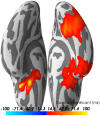A Reproducible MEG/EEG Group Study With the MNE Software: Recommendations, Quality Assessments, and Good Practices
- PMID: 30127712
- PMCID: PMC6088222
- DOI: 10.3389/fnins.2018.00530
A Reproducible MEG/EEG Group Study With the MNE Software: Recommendations, Quality Assessments, and Good Practices
Abstract
Cognitive neuroscience questions are commonly tested with experiments that involve a cohort of subjects. The cohort can consist of a handful of subjects for small studies to hundreds or thousands of subjects in open datasets. While there exist various online resources to get started with the analysis of magnetoencephalography (MEG) or electroencephalography (EEG) data, such educational materials are usually restricted to the analysis of a single subject. This is in part because data from larger group studies are harder to share, but also analyses of such data often require subject-specific decisions which are hard to document. This work presents the results obtained by the reanalysis of an open dataset from Wakeman and Henson (2015) using the MNE software package. The analysis covers preprocessing steps, quality assurance steps, sensor space analysis of evoked responses, source localization, and statistics in both sensor and source space. Results with possible alternative strategies are presented and discussed at different stages such as the use of high-pass filtering versus baseline correction, tSSS vs. SSS, the use of a minimum norm inverse vs. LCMV beamformer, and the use of univariate or multivariate statistics. This aims to provide a comparative study of different stages of M/EEG analysis pipeline on the same dataset, with open access to all of the scripts necessary to reproduce this analysis.
Keywords: Python; electroencephalography (EEG); magnetoencephalography (MEG); neuroimaging; open-source; software.
Figures












References
-
- Baayen R. H., Davidson D. J., Bates D. M. (2008). Mixed-effects modeling with crossed random effects for subjects and items. J. Mem. Lang. 59, 390–412. 10.1016/j.jml.2007.12.005 - DOI
-
- Bigdely-Shamlo N., Kreutz-Delgado K., Robbins K., Miyakoshi M., Westerfield M., Bel-Bahar T., et al. (2013). Hierarchical event descriptor (HED) tags for analysis of event-related EEG studies, in Global Conference on Signal and Information Processing (GlobalSIP) (IEEE; ) (Austin, TX: ), 1–4.
Grants and funding
LinkOut - more resources
Full Text Sources
Other Literature Sources

